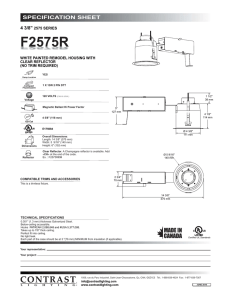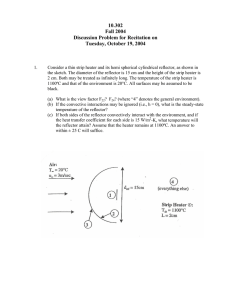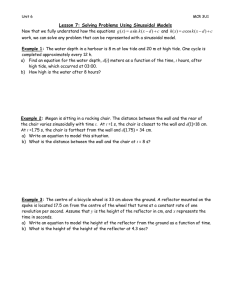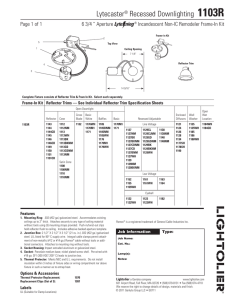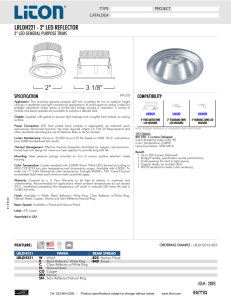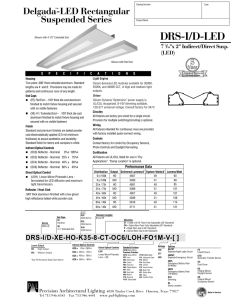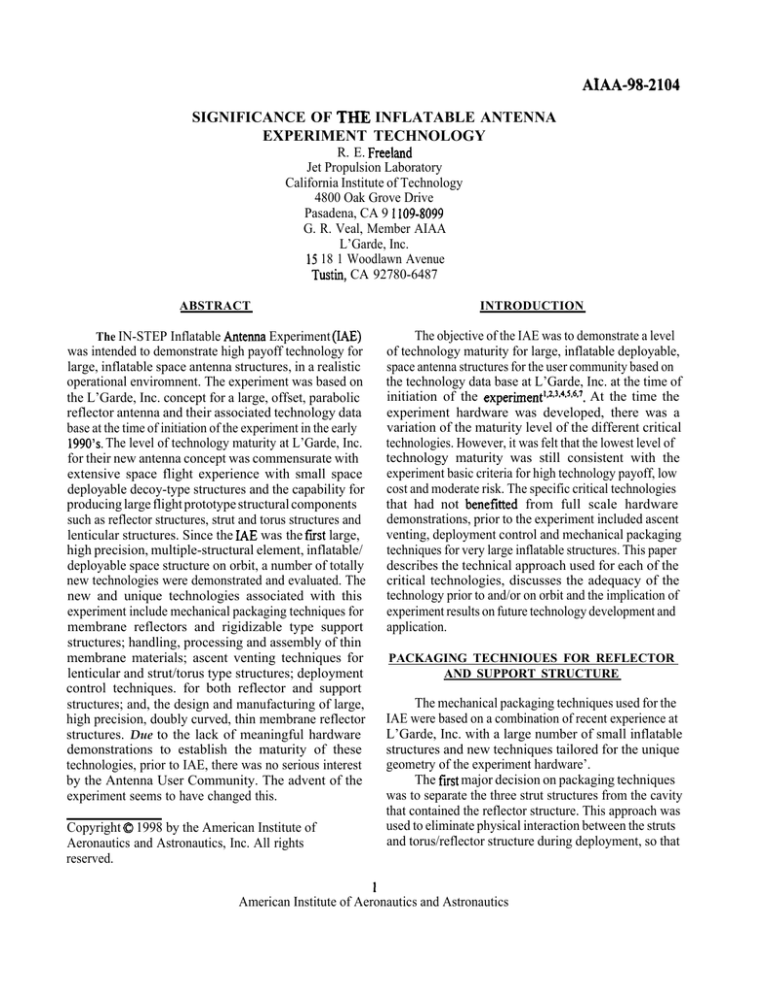
AIAA-98-2104
SIGNIFICANCE OF TJ3E INFLATABLE ANTENNA
EXPERIMENT TECHNOLOGY
R. E. Freeland
Jet Propulsion Laboratory
California Institute of Technology
4800 Oak Grove Drive
Pasadena, CA 9 1109-8099
G. R. Veal, Member AIAA
L’Garde, Inc.
15 18 1 Woodlawn Avenue
Tustin, CA 92780-6487
ABSTRACT
INTRODUCTION
The IN-STEP Inflatable Antema Experiment (IAE)
was intended to demonstrate high payoff technology for
large, inflatable space antenna structures, in a realistic
operational enviromnent. The experiment was based on
the L’Garde, Inc. concept for a large, offset, parabolic
reflector antenna and their associated technology data
base at the time of initiation of the experiment in the early
1990’s. The level of technology maturity at L’Garde, Inc.
for their new antenna concept was commensurate with
extensive space flight experience with small space
deployable decoy-type structures and the capability for
producing large flight prototype structural components
such as reflector structures, strut and torus structures and
lenticular structures. Since the IAE was the fast large,
high precision, multiple-structural element, inflatable/
deployable space structure on orbit, a number of totally
new technologies were demonstrated and evaluated. The
new and unique technologies associated with this
experiment include mechanical packaging techniques for
membrane reflectors and rigidizable type support
structures; handling, processing and assembly of thin
membrane materials; ascent venting techniques for
lenticular and strut/torus type structures; deployment
control techniques. for both reflector and support
structures; and, the design and manufacturing of large,
high precision, doubly curved, thin membrane reflector
structures. Due to the lack of meaningful hardware
demonstrations to establish the maturity of these
technologies, prior to IAE, there was no serious interest
by the Antenna User Community. The advent of the
experiment seems to have changed this.
The objective of the IAE was to demonstrate a level
of technology maturity for large, inflatable deployable,
space antenna structures for the user community based on
the technology data base at L’Garde, Inc. at the time of
initiation of the experiment’~2~3*4~5~6*7. At the time the
experiment hardware was developed, there was a
variation of the maturity level of the different critical
technologies. However, it was felt that the lowest level of
technology maturity was still consistent with the
experiment basic criteria for high technology payoff, low
cost and moderate risk. The specific critical technologies
that had not benefitted from full scale hardware
demonstrations, prior to the experiment included ascent
venting, deployment control and mechanical packaging
techniques for very large inflatable structures. This paper
describes the technical approach used for each of the
critical technologies, discusses the adequacy of the
technology prior to and/or on orbit and the implication of
experiment results on future technology development and
application.
Copyright 0 1998 by the American Institute of
Aeronautics and Astronautics, Inc. All rights
reserved.
PACKAGING TECHNIOUES FOR REFLECTOR
AND SUPPORT STRUCTURE
The mechanical packaging techniques used for the
IAE were based on a combination of recent experience at
L’Garde, Inc. with a large number of small inflatable
structures and new techniques tailored for the unique
geometry of the experiment hardware’.
The fast major decision on packaging techniques
was to separate the three strut structures from the cavity
that contained the reflector structure. This approach was
used to eliminate physical interaction between the struts
and torus/reflector structure during deployment, so that
American Institute of Aeronautics and Astronautics
AIAA-98-2 104
in the stowed structure would have minimal impact on the
planned deployment sequence. Based on the actual orbital
performance, the combination of such packaging
techniques, along with the appropriate control
deployment devices, now under development at L’Garde,
Inc., is expected to result in a highly controlled
deployment sequence.
separate control techniques could be used for each
element of the support structure.
The highest mechanical packaging efficiency for the
struts results from folding them in a “2” configuration
with a separate container for each structure, referred to as
“pods”. This arrangement allows the struts to be pulled
from their pods by the inertial forces Corn the reflector
structure without interaction between them or the torus
structure during the deployment.
The folding technique used for the reflector
structure, which consists of the lenticular structure and
the torus, was driven by the folding pattern of the torus
structure. In order to interface the ejection plate with the
most durable inflatable structure, the torus, the three
segments of the torus, located between the joints with the
struts, were folded into short/wide-pedestal type packages
and placed parallel to each other on the ejection plate.
The center part of the lenticular structure, which was not
constrained by the torus at its outer perimeter, was folded
into a “z” pattern and then located on top of the stowed
torus structure. This packaging technique resulted in a
near rectangular configuration that fit into the rectangular
canister structure, Figure 1. However, since the canister
HANDLING, PROCESSING AND ASSEMBLY
OF MEMBRANE MATERL4LS
The reflector structure consisted of 62 ahrminized
Mylar gores that were 7 microns thick. Their geometric
shape was based on an analytical process that utilized
special computer codes. The membrane material is stored
on rolls that are one meter wide. The surfaces of the
tables and fixturing which were used to support the
delicate membrane material must be very smooth and free
of sharp obstacles. The cutting of the gores is done by a
computer controlled laser machine. The membrane
material is fed from its storage roll onto a table that
supports the mobile-cutting tool. The gore shaped
segments are then cut from the flat fihn. The gores are
folded/transported/assembled by hand’. The assembly
process consists of placing the edges of two gores
precisely against each other while being supported by
curved tooling. At that time a tape doubler is placed over
the two adjoining gore edges and bonded to them. During
this process the gore material is supported by tables
adjacent to the tooling. The placement of the membrane
on the tooling and its support during the bonding
operation is all done by hand. The assembled portion of
the reflector is then folded into bundles for ease of its
movement away from the assembly area.
Handling of the completed 14-meter-diameter
reflector membrane structure is accomplished in a number
of ways. The structure is transported by folding it into a
bundle which can be placed in a container. Evaluation of
the reflective-surface precision and the operations
involving its assembly with the canopy structure both
require that it be unfolded into a planar configuration and
tensioned around its perimeter. To accomplish this handling operation, a number of people were stationed around
the perimeter ofthe membrane to apply very light loading
at discrete points for purposes of (a) stretching the
membrane so it can be mounted on a fixture, Figure 2, (b)
positioning it for assembly with its canopy and(c) folding
it abler its attachment to the canopy. These procedures
worked well for the 14-meter diameter IAE reflector. It is
estimated that these same procedures and processes will
Figure 1. Packaging ConjTguration
shape was rectangular, and the fmal stowed configuration
of the reflector structure was not exactly rectangular,
dumrage was used to fill the voids. The dunnage was
made from low-density honeycomb and its purpose was
to prevent movement of the stowed reflector structure
during the boost phase of the flight. Signiticant
movement might have affected the planned orbital
deployment sequence. These packaging techniques were
based on the assumption that the amount of residual gas
L
American Institute of Aeronautics and Astronautics
AMA-98-2104
mounted directly on top of the flexible rim structure. At
this point the canopy is bonded directly to the top surface
of the flexible rim. The interface of the lenticular with the
torus is this flexible rim, which has 260 small holed at its
edge to accept flexible ties from the torus structure.
LENTICULARTORUS STRUCTURES
Figure I. Mountwzg Membrane on Test Fixture
accommodate the manufacture of reflectors up to “on the
order of’ 25 meters in diameter. Beyond that point, new
and possibly semi-automated techniques will probably be
required.
ANTENNA STRUCTURE ASSEMBLY
The techniques and approaches used for the
assembly of inflatable deployable structures is dependent
on a number of variables that include the materials
characteristics, the size, mass, thickness and shape of the
structural elements, the nmnber of parts in the assembly,
and the alignment tolerance. One of the most significant
challenges for this type of structure is the assembly of
large area, ultra-thin membrane structures such as the
reflector and canopy structure for a large reflector
antenna, such as the IAE.
The fust step in the assembly of the torus to the
lenticular is to establish a reference plane for the torus
that represents a zero “g” loading configuration. The
reason for this is that the lenticular is attached to the torus
along this plane with 260 flexible adjustable ties. The
zero “g” plane is established by submerging the torus in
a large trough in a neutrally buoyant condition. When the
unstressed configuratio’n is achieved, a true plan is
marked on the interior of the torus. Attachment hardware
is then bonded to the torus structure. Assembly was
achieved when the attachment hardware on each of the
two structures was connected while they were in an uninflated configuration. Once the assembly was complete,
both structures were inflated and each of the 260 tie
points was adjusted to achieve the required radial loading
to the lenticular structure.
TORUS/STRUTS/CANISTER STRUCTURE
The attachment of the struts to the torus was
relatively simple in that a rigid adapter ring was used to
interface the strut end fitting to a fitting that was bonded
on the torus. Attachment of the struts to their pods which
were part of the canister structure, involved attachment of
the strut end fittings to their “register” on their pods.
LENTICULAR STRUCTURE
ASCENT VJZNTING
The lenticular structure consists of the reflector and
canopy structures which are interfaced by means of a thin
flexible torodial ring. Assembly begins with the mounting
of the reflector structure on a “ring type” fixture that
supports it at its outer diameter with a flange. It is aligned
on the fixture so that the desired annular bonding area is
directly over the top flange of the fixture. At this time, a
differential pressure is applied across the reflector
structure for purposes of removing all the wrinkles m the
membrane in the area to be bonded. Next the flexible
toroidal rim structure is placed over the flange supported
area of the reflector membrane and bonded to it. The
canopy structure is then placed over the reflector
structure, which is still mounted on its fixture, such that
the pre-determined bonding area on the canopy is
The ascent venting issues associated with these
types of space structure were accounted for in the design
of the IAE hardware’. However, due to the lack of space
flight experience with this specific type and size of
inflatable space structure, the effectiveness of the
techniques used was not really adequate. Increasing the
effectiveness of IAE ascent venting technology, and/or
the development of new techniques will be used for the
next flight of this type of inflatable structure.
TORUS AND STRUT STRUCTURE
The basic approach for ascent venting of the basic
IAE support structure was to use bleeder cloth 0.25mm x
3
American Institute of Aeronautics and Astronautics
AMA-98-2104
1Ocm along the full length of the struts and torus. This
cloth was attached to the end fittings that interfaced the
struts with the torus and the struts to their pods.
Simulation of the launch environment in the vacuum
chamber using full-scale prototype hardware indicated
that the gas flow path in the struts and torus was not
nearly sufficient to bring the residual air down to the
point required prior to orbital deployment. The bleed
cloth was then replaced with flexible lanyards whose
diameter was considerably larger than the thickness of the
bleed cloth. Further simulations in the vacuum chamber
using full-scale strut structures indicated that three
lanyards were needed for each strut and the torus. The
flight results showed improvement over the bleeder cloth
approach, as evaluated in the chamber, but not enough to
enable the deployment control desired. It is believed that
the very high mechanical packaging associated with the
struts in their individual pods resulted in high enough
loading of the membrane against the lanyards to minimize
the gas flow around the lanyards. Additionally, it appears
that there was enough residual gas in the ML1 blankets,
even though they were vented, to contribute to the
deployment anomaly. A longer time in orbit prior to
deployment would have significantly contributed to less
residual gas in the stowed support structure and the
lenticular structure.
from its launch container prior to initiation of its own
“,” .This way the inertially-loaded reflector
deployment
structure would essentially “pull” the struts out of their
launch containers in a near uniform manner. When the
struts were stretched to about 80% of their deployed
length, a gas flow path would be developed and at that
time inflation gas was to be introduced to all three struts
at their intersection with the canister structure. While the
struts were being pulled from their pods, a low rate of
deployment of the lenticular structure would be initiated
from the release of strain energy from the inflatable
materials and a small amount of residual gas in both the
torus and lenticular structure. The plan was that when the
struts were nearly completely deployed, inflation gas
would be introduced to the already partially deployed
reflector structure in order to complete its deployment,
Figure 3.
LENTICULAR STRUCTURE
The basic approach used for venting ofthe lenticular
structure was to incorporate several dozen, lmm diameter
holes around the edge of the reflector structure. This
approach appeared to be very simple and for a one-orbit
experiment, the inflation gas loss would be trivial.
However, on orbit there was still sufficient residual gas to
cause “pillowing” of the entire lenticular structure as soon
as its launch container was opened. This did not appear to
have a detrimental affect on the deployment, but was not
desired. It is believed that the compact packaging of the
lenticular structure resulted in blockage of the vent holes
from other areas of the membrane structure. This suggests
that some type of large orifice valves, that could be closed
prior to deployment, may provide a more effective gas
flow path. Another option would be the “vacuum pack”
used in the Echo Balloon Series9.
DEPLOYMENT CONTROL
The basic deployment scheme for IAE was based on
ejecting the stowed reflector structure, as a package, away
Figure 3 Pluntwd Deployment Sequence
On orbit the magnitude of residual gas and the strain
energy in the stowed structure was significantly more
than anticipated. As a consequence, the plamred
deployment sequence did not materialize. Instead, the
reflector structure deployed prematurely so that its
planned ejection away from the canister did not take
place. By the time the struts migrated from their pods as
a consequence of residual gas and material strain energy,
the reflector structure was over half deployed. However,
due to the robust nature of this type of space structure, the
torus and two of the struts completed deployment at about
the same time and complete deployment of the third strut
followed within a minute or two, Figure 4.
The results of the IAE strongly suggest that to
achieve precise control of large inflatable structural
elements, deployment control devices are required’*~‘3~‘4.
Such devices would be integrated directly into support
structures, such as struts and toruses. A number of
4
American Institute of Aeronautics and Astronautics
AMA-98-2104
Figure 4b.
Figure 4a.
Figure 4d.
FIgwe -le.
Figure 4. Actual Orbital Deployment Sequence
5
American Institute of Aeronautics and Astronautics
AMA-98-2104
folded, transported and aligned for assembly by hand.
The gores were assembled, two at a time over curved
tooling that represented the fmal reflector shape. The
edges of the two gores were then butted together on the
tooling so they could be joined together by the bonding of
a tape doubler over both edges of the gores. As the gores
were assembled, the completed part of the reflector
structure was folded by hand into a long narrow bundle.
When the assembly of the reflector was complete,
the determination of its precision was done by placing the
reflector structure on a ring-shaped fixture the same
diameter as the structure. It was then stretched and
attached to the fixture along its outer edge. Then the same
pressure differential, plamred for orbit, was applied to the
edge supported membrane. The surface precision was
measured with photogrammetric techniques. The surface
precision achieved was on the order of 2mm RMS, for the
portion of the reflector about a meter away from its edge,
Figure 5. This is the portion of the reflector that would
normally be used for actual RF operation.
different types of control devices concepts have ah-eady
been developed. A very promising approach would be to
stow the support structure elements around a mandrel so
that its rate of deployment could be controlled by
adjusting the gap that the flexible material passes through.
Deployment control of the lenticular type structures is
also required to prevent “billowing” of the membrane
structure prior to complete deployment of its support
structure. Techniques to consider might include (a) ascent
venting with mechanical valves, (b) vacuum packing prior
to launch and (c) a restraint system for the stowed
reflector structure that releases to enable its deployment
in the appropriate time frame.
HIGH PRECISION MEMBRANE REFLECTURE
STRUCTURES
The surface precision of the inflatable deployable
membrane reflector structure is a function of many
variables which include (a) the geometry of the flat gores
that are assembled to produce the reflector, (b) the
properties of the materials used for the gores, (c) the
cutting of the gores from the as manufactured materials,
(d) the handling of the gores, (e) the assembly of the
gores, and (f) the boundary condition of support for the
reflector structure after integration with the complete
antenna.
The procedures used for the IAE started with the
selection of material which was 7-micron-thick
aluminized Mylar. This material was available, in the
thickness needed and had a low enough modulus to
enable the required handling, processing and the assembly
of the reflector. The determination of the gore shapes is
done analytically. A L’Garde, Inc. computer code called
FLATE solves the inverse problem of starting with the
desired orbital shape, desired operating membrane stress
and materials properties and calculates the unstrained flat
gore shapes. The next step was to use the gore shape data
as input to another L”Garde, Inc. Code called FAIM. This
code accounts for all of the important manufacturing and
assembly tolerances and then determines the reflector
surface precision that can be expected for a given level of
materials manufacturing and processing standards. This
interactive analytical process is used until the projected
surface precision is consistent with the design
requirements.
The next step was the cutting of the gores, which
was done with a computer controlled laser cutter. The
required geometric precision of the finished gores was
achieved to within 200 microns. The gores were then
Figure 5. Reflector hfembrane Mounted on Assembly
Ring
The resulting surface precision of the as
manufactured IAE reflector represented the level of
technology available at L’Garde, Inc. during 19934,s.
Subsequent to that time, a number of advancements have
been made to a number of the technologies affecting the
reflector surface precision. For example, the current
NASA sponsored technology program at L’Garde, Inc. is
contributing to even further advancements. Consequently,
future applications of this technology can expect much
higher reflector precision than demonstrated by the IAE.
CONCLUSIONS
The conclusions address how well the critical
technologies demonstrated on orbit met the objectives of
6
American Institute of Aeronautics and Astronautics
AMA-98-2104
the experiment and the needs of finme experiments and
applications of this technology.
The deployment control of each major structural
element, including the canopy, is required to maintain
high reliability. The actual orbital deployment was
complete and successful due to the robust nature of
inflatable deployable structures. The need for major
improvement of ascent venting techniques was obvious
and is currently being addressed. The low cost of these
new types of space structure was demonstrated by
building a large reflector structure for on the order of one
million dollars. The outstanding mechanical packaging
efficiency was demonstrated by stowing an antenna
structure the size of the STS into a container the size of
an offtce desk. The high surface precision of the
membrane reflector structure validated procedures for the
design, materials processing, and assembly for this type
of structure. Since this reflector was the fust of its type,
modifications and/or refmements of the processes are
expected to result in much-higher precision reflectors.
The successful development of this very large inflatable
antenna structure validated the processes, handling and
procedures used for manufacturing inflatable support
structures and membrane reflector and canopy structures.
The technology used for the experiment, validated by the
experiment and the resulting requirements for the future
development of technology represent the new technical
data base for this new class of space structures.
2.
Freeland, R. E. and Bilyeu, G., “IN-STEP Inflatable
Antenna Experiment,” Acta Astronautica Vol. 30,
pp. 29-40, 1993.
3.
Satter, Celeste M. and Freeland, Robert E.,
“Inflatable Structures Technology Applications and
Requirements,” AIAA Paper 95-3737, presented at
the Space Programs and Technical Conference,
Huntsville, AL, September 26-28, 1995.
4.
Freeland, R. E., Bilyeu, G.D., and Veal, G. R.,
“Development of Flight Hardware for a Large,
Inflatable-Deployable Antenna Experiment,” IAF
Paper 95-1,5.0,1, presented at the 46* Congress of
the International Astronautical Federation, Oslo,
Norway, October 2-6, 1995.
5.
Freeland, R. E., Bilyeu, G. D., and Veal, G. R.,
“Development of Flight Hardware for a Large,
Inflatable-Deployable Antenna Experiment,” Acta
Astronautica, Vol. 38, Nos. 4-8, pp. 25 l-260,1996.
6.
Thomas, M.; Veal, G., “Highly Accurate Inflatable
Reflectors, Report AFRPL TR 84-023, Prepared for
the Air Force Rocket Propulsion Laboratory, dated
May 1984.
7.
Thomas, M., Veal, G., “Scaling Characteristics of
Inflatable Paraboloid Concentrators”, Presented at
the Second ASME-JSES-JSME International Solar
Energy Conference, Rena, Nevada, March 17-22,
1991.
8.
Veal, G., and Freeland, R., “IN-STEP Inflatable
Antenna Description,” AIAA Paper 95-3739,
presented at the Space Programs and Technologies
Conference, Huntsville, AL, Sept. 26-28, 1995.
9.
Hanson, James, R., “The Big Balloon,” Aerospace
Magazine, pp. 70-77, April/May 1994.
ACKNOWLEDGMENTS
The research described in this paper was carried out
at the Jet Propulsion Laboratory, California Institute of
Technology under a contract with the National
Aeronautics and Space Administration and at the
Goddard Space Flight Center. Development of the
experiment flight hardware, evaluation of the flight data
and the specific technical recommendations for continued
technology development was done by L’Garde, Inc. under
contract to JPL.
REFERENCES
1.
Freeland, R. E. and Bilyeu, G., ‘IN-STEP Inflatable
Antenna Experiment,” IAF Paper 92-0301,
presented at the 43rd Congress of the International
Astronautical Federation, Washington, D.C., Aug.
28-Sept. 5, 1992.
10. Freeland, R. E., Bilyeu, G., and Veal, G. R.,
“Validation of a Unique Concept for a Low-Cost,
Lightweight Space Deployable Antemra Structure,”
IAF Paper 93-1.1.204, presented at the 44th
Congress of the International Astronautical
Federation, Graz, Austria, Oct. 16, 1993.
Il. Freeland, R. E. Bilyeu, G., and Veal, G. R.,
“Validation of a Unique Concept for a Low-Cost,
7
American Institute of Aeronautics and Astronautics
AMA-98-2 104
Lightweight Space Deployable Antenna
Structure,” Acta Astraonautica, Vol. 35, No. 911, pp. 565-572, 1995.
12. Freeland, Robert; Bard, Steven; Veal, Gordon;
Bilyeu, Gayle; Cassapakis, Costa; Campbell,
Thomas and Bailey, M. C., “Inflatable Antemra
Technology With Preliminary Shuttle Experiment
Results and Potential Applications,” presented at the
18* Annual Meeting and Symposium of the
Antenna Measurement Techniques Association,
S e p t e m b e r 30-October 3, 1996, Seattle,
Washington.
13. Freeland, R. E. Bilyeu, G. D., and Veal, G. R.,
“Large Inflatable Deployable Antenna Flight
Experiment Results,” IAF Paper 97-1.3.01,
presented at the 48’ Congress of the International
Astronautical Federation, Turin, Italy, October 6-10,
1997.
14. “Preliminary Mission Report:
Spartan
207/inflatable Antenna Experiment Flown on STS77”, Spartan Project, NASA-GSFC, Feb. 14, 1997.
8
American Institnte of Aeronautics and Astronautics

